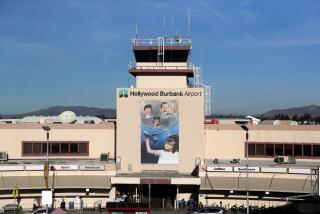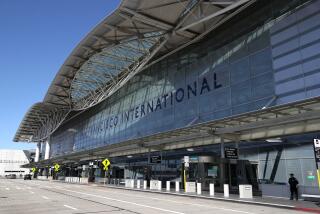Burbank Airport : FAA Says Chief Willing to Meet About Terminal
- Share via
The head of the Federal Aviation Administration is willing to meet with Burbank Airport officials to discuss the airport’s problems in complying with FAA directions to build a new terminal, the FAA has said.
The FAA replied this week to a request from Robert W. Garcin, president of the Burbank-Glendale-Pasadena Airport Authority, for a meeting with FAA Administrator Donald D. Engen to discuss the expense of meeting FAA requirements.
There was no mention in the reply of a request by Garcin to meet with Transportation Secretary Elizabeth Hanford Dole. But airport spokesman Victor J. Gill said Garcin would continue to try to arrange such a meeting.
The authority has asked Rep. Carlos J. Moorhead (R-Glendale) to ask Dole to meet with Garcin.
A letter to Garcin from Herman Bliss, manager of the Airports Division of the FAA’s Western-Pacific Region, said a meeting with Engen could be arranged if Garcin first meets with regional FAA officials and submits reports on the financial and environmental consequences of the choices the airport faces.
Terminal Too Near Runway
The FAA has been urging the authority to replace the 56-year-old terminal, which is only 300 feet from the runway center at points, less than half the 750-foot safety zone the FAA now requires.
The airport has been operating under waivers for some years while discussing replacement of the terminal. But five years of planning to build it on Lockheed-owned land on the east side of the airport collapsed in December when the Defense Department ruled that the site was too close to the “Skunk Works,” where Lockheed works on secret military projects.
After that, the FAA began insisting on immediate safety modifications to airport operations until a new terminal is built.
A ban was imposed on takeoffs to the east. United Airlines Boeing 767s, which will be the largest commercial passenger planes using the airport when United begins service to Chicago next week, will not be allowed to park with other jetliners between the terminal and the runway. The 767s will park in an open area across the runway, and passengers will be taken to and from them by bus.
Loss of Parking Revenue
In one of the most financially painful requests for the airport, the FAA urged conversion of 1,457 auto parking spaces into aircraft parking space to move parked jetliners farther from the runways. The authority balked because of the cost. The parking spaces generated $1.7 million in fees last year, one of the chief financial supports for the airfield.
The authority responded with an offer to convert a parking area for about 450 autos, just east of the terminal, into a jetliner parking area.
In his letter, Bliss accepted the proposal but said the authority “should consider” a similar conversion of the rental car parking lot immediately south of the PSA terminal.
Garcin has warned in the past that the financial burden of meeting the FAA demands, plus the potential cost of adverse court rulings on noise nuisance lawsuits, may drive the airport out of existence.
In his request for a meeting with Engen and Dole, Garcin wrote the FAA on April 8 that “large sums of money will be necessary” to build a new terminal “and we desperately need your direction on the financing of any site finally chosen.”
Garcin’s letter said, “It has become obvious that conventional financing through airport revenues and Airport Improvement Program funds appears to be inadequate to resolve the problem. Since we do not have an economically viable long-term program, and since the short-term plan has adverse financial impacts, we did not wish to commence the short-term work until we have had a meeting with Administrator Engen and Secretary Dole.”
More to Read
Sign up for Essential California
The most important California stories and recommendations in your inbox every morning.
You may occasionally receive promotional content from the Los Angeles Times.










